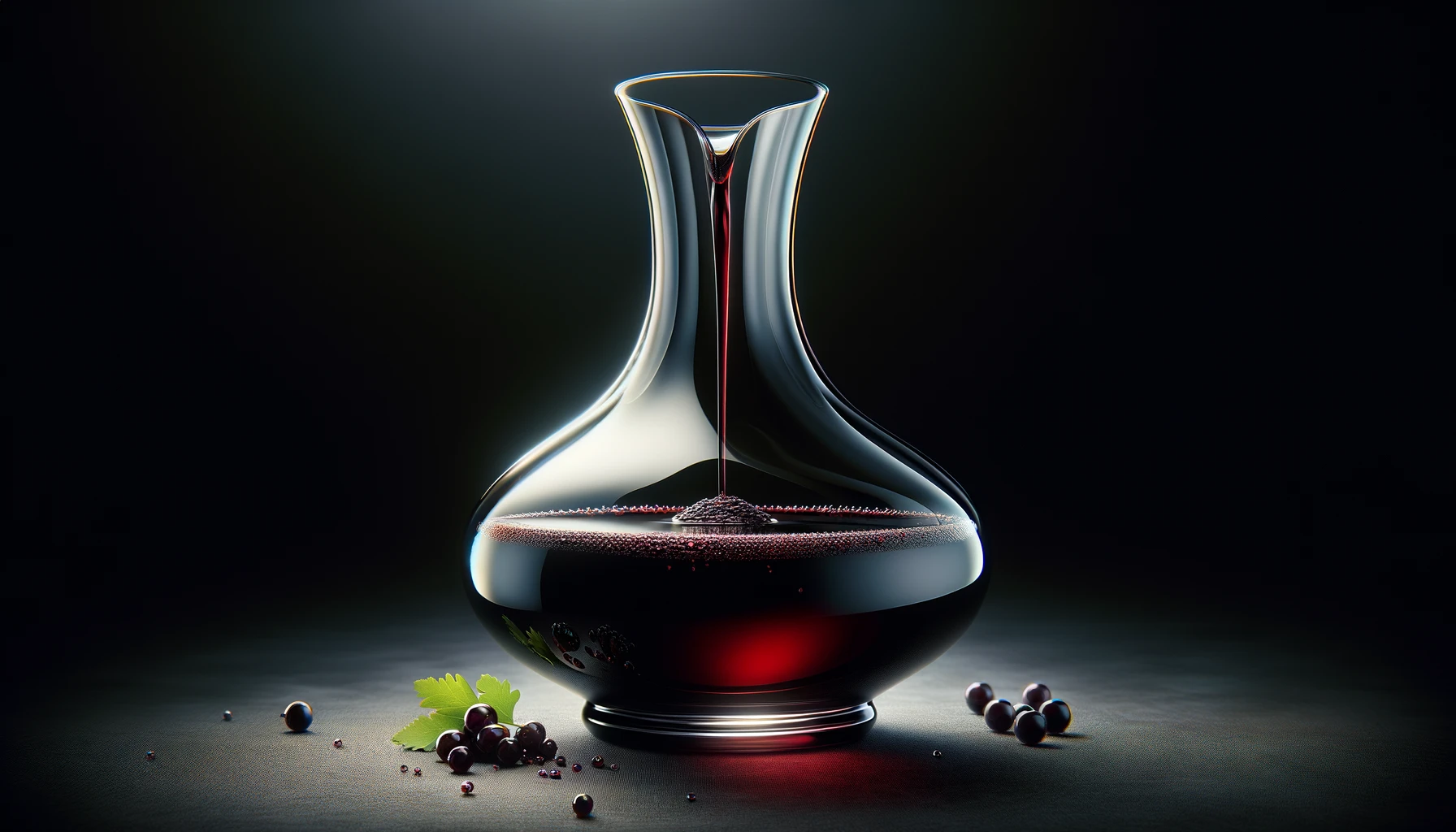Why do some wines have sediment?
That moment when you pour a glass of your favorite red and find a gritty surprise at the bottom?
Ick.
This unexpected guest is more than just an uninvited plus-one to your wine party; it’s a tale as old as winemaking. Imagine tiny dancers—tannin

Sediment may seem wrong, but hold on… As you delve into the nuances of these beautiful wines, remember that patience and proper technique can enhance your tasting experience to new levels. Whether it’s bringing out hidden flavors or softening tannins
The Nature and Origin of Wine Sediment
Ever notice the gritty stuff at the bottom of your wine glass? That’s wine sediment, a mix of dead yeast cells, grape particles, and bits that enter your bottle during the winemaking process. While some think it means poor quality, it’s a sign of natural processes at work.
Grape Particles and Yeast Cells – Unseen Architects of Sediment
Grape skins and seeds left behind from crushing can become part of this grainy bunch. When wine ferments, yeast munches on the grape skin for sugars; once they’ve done their job, these now-dead yeast cells join the party as lees sediment.
Sediments are more than just leftovers; they prove that you’re sipping on something tangible, like finding flour in homemade bread. They tell you about little intervention or hands-off approaches to making wine, where every speck tells part of its story.
Chilling Effects – The Formation of Tartrate Crystals
A remarkable fact about white wines is that sometimes those clear diamonds you see are tartaric acid turning into tartrate crystals—especially after cold stabilization in refrigeration. These wine diamonds are utterly natural bling with zero impact on taste.
Decanting Wines with Sediment
Ever wondered why some wines leave a gritty surprise in your glass, especially reds? That gritty surprise is wine sediment, and far from indicating a poor quality wine, it’s often a hallmark of a well-aged, high-quality vintage. As a dedicated wine enthusiast who relishes the nuances of aged wines, decanting is a crucial step in preserving the drinking experience.
Aging Wine and Its Impact on Sediment Accumulation
Well-aged red wines are like a story unfolding in a glass. Over time, wine’s phenolic molecules begin a complex dance, eventually combining to form tannin
This natural process adds character to finished wine and creates wine sediment. It’s common for wines around ten years post-vintage to show these signs of maturity as particles settle out of suspension and gather at the bottom of the bottle.
Tannins Transform – The Evolution into Fine Sediment Accumulation Over Time
The journey wine ages from vibrant liquid to one with wine diamonds or tartrate crystals tells us about more than just age. These burgundy-colored diamonds signify that our favorite reds have been given the gift of time, allowing their flavors to deepen and evolve.
Sediments can be disturbing surprises, but they’re indicators that you’re about to enjoy something special—a high-quality wine with layers of complexity crafted through careful aging affects sediment in wines.
Sediment as an Indicator of Minimal Intervention Winemaking
When you spot dregs, crystals or other solids at the bottom of your wine glass, sediment falls, so don’t fret. This is a sign that the winemakers might have taken a hands-off approach. We call this minimal intervention winemaking. It’s about permitting nature to take its course.
Natural byproducts like spent yeast are not harmful; they show that less filtration and processing were used. Sediment proves your wine has been living its best life, developing flavors without much human meddling.
Bottle aging allows phenolic molecules to combine and form tannin
Red Wines’ Relationship with Lees Sediment
Ever wonder why your glass of red wine sometimes has a bit more character? It’s likely due to lees sediment, those little bits that tell a story of the wine’s journey. This relationship is unique in red wines.
Aging on their lees gives red wines depth and complexity. Consider it akin to investing additional time with a cherished pal – the rewards are worth it. While white wines might also spend some time on their lees, reds often take more extended vacations in their company.
This extended hangout allows for subtle flavors and textures to develop; hence, you may notice these sediments are more in red than white varieties. But don’t be fooled—these gritty guests are not signs of poor quality but marks of meticulous crafting over a long period.
Exploring Consumer Perceptions About Wine Quality And Sediment
Sediment in your wine bottle might seem like a bad sign, but some wine lovers see it differently.
To many, those little bits floating around or sitting at the bottom of a glass remind them of traditional winemaking. They can be grape particles or yeast cells left over from the fermentation process. These tiny leftovers make each bottle unique and can signal quality, especially in high-quality red wines.
Appreciating Texture – When Grit Meets Palate
We often think smoothness is better when we drink wine. But texture – even a bit of grittiness – can add character.
The ‘grit’ in wine crystals could be tartrate crystals, also known as ‘wine diamonds,’ which tend to appear more in white wines after chilling. Far from being signs of poor quality, these clear diamonds tell us that the wine hasn’t been over-processed.
Vintage Value – Assessing Age Through Deposits
A well-aged vintage often comes with something extra: sediment deposits.
This isn’t just any old sludgy mess; it’s formed by tannin
FAQs about Why Some Wines Have Sediment
Does sediment in wine mean it’s good?
Sediment often signals a well-aged white wine is, hinting at the maturity and complexity that some oenophiles chase after.
How much sediment is too much in wine?
Some sediment is normal, especially in aged wines; heaps might suggest storage issues or over-aging.
Can you remove sediment from wine?
You can clear up your vino by decanting or filtering to catch those gritty bits before serving.
How do you serve wine with sediment?
Gently pour the bottle into a decanter. Let gravity keep the muck at bay for a smooth sip.
The Last Pour
Remember this: Sediment tells a story. The history of wine locked in tiny particles whispers tales of aging and craftsmanship.
Notice the tartrate crystals? They’re clear diamonds signaling natural processes, not flaws high quality bottle. The red wine dregs at the bottom of your glass mark time spent enhancing flavors.
Embrace decanting as an art form. It’s your gateway to purity and taste without disturbing precious sediments.
Acknowledge sediment as a natural occurrence and a sign of patience—a virtue in winemaking that often hints at the quality you can savor with every sip. These are nature’s markers; let them guide your appreciation for each pour.



![Why Are Some Wines Described as Buttery? | [WSET4]](https://grapeandbarrel.com/wp-content/uploads/2024/04/01af0647-bfac-424a-bd94-f220d92fd621-768x439.png)
![How to Properly Store Open Wine Bottles | [WSET-3 Reviewed]](https://grapeandbarrel.com/wp-content/uploads/2024/04/55795bf5-78f1-4fd4-a7a9-e4f691c982eb-768x439.png)

![What is Trento DOC Sparkling Wine? [WSET2 Reviewed]](https://grapeandbarrel.com/wp-content/uploads/2024/04/0oflrry-rim1712673478-768x432.jpg)
